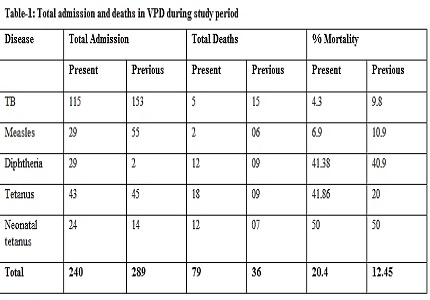To study the Knowledge regarding immunization schedule among parents and the source of information regarding vaccination
Abstract
Background: Immunization, the most cost-effective public health intervention, continues to be under-used. It is profoundly tragic that almost two million children still die each year from disease for which vaccines are available at low cost. The aim of study is to correlate parents knowledge practices and children immunization completeness.
Material & Methods: A one year prospective cross-sectional study was carried out on children admitted in Pediatric ward of Kamla Nehru hospital, Gandhi Medical College, Bhopal. Total 240 cases as any of the six VPDS were studied according to a pre-designed proforma. Knowledge about vaccination, age, place and person were collected among parents and recorded along with the reason for non-vaccination. A comparison with trend five years back in the same hospital was done.
Result: In present study the highest incidence was of TB 47.92% followed by tetanus, measles, diphtheria & neotetanus. Highest mortality is of tetanus neonatorum followed by tetanus, Diphtheria, Measles & tuberculosis in descending order, among 240 admitted patients. The incidence of VPDS was higher among unvaccinated child as compared to vaccinated child except tuberculosis where vaccination rate was higher (52.17%) and all VPDS were much common in illiterate fathers and mothers.
Conclusion: There is a need to increase awareness and knowledge about the benefits and importance of vaccination, as well as the harmful consequences of non-complete immunization. A planned educational programme is needed; the educational level of the parents needs to be taken into consideration when the programme is planned, especially as regards those with a lower educational level.
Downloads
References
2. Farag MK, Al-Mazrou YY, Al-Jefry M, Al-Shehri SN, Baldo MH, Farghali M. National immunization coverage Saudi Arabia. Journal of Tropical Pediatrics 1995; 41:59-67.1.Med Pregl. 2005 Jul-Aug;58(7-8):333-41. [PubMed]
3. Petrovic V, Seguljev Z, Gajin B. Maintaining the cold chain for vaccines. Med Pregl.2005; 58:333-41. [PubMed]
4. Immunization Handbook for Medical officers; Dept of Health & Family Welfare, Govt. Of India;pagel0,15 available on nihfw.org.
5. World Bank, World Development Indicators (www.google.com/publicdata as accessed on 13.5.2010 )https://www.google.com/publicdata
6. Singh MC, Badole CM, Singh MP. Immunization coverage& knowledge & practice of mothers regarding Immunization in Rural India. Indian J. Pub.Hlth. 1994; 38. 103-7.
7. D Adeyinka, O Oladimeji, F Adeyinka, C Aimakhu Uptake Of Childhood Immunization Among Mothers Of Under-Five In Southwestern Nigeria The Internet Journal of Epidemiology. 2008 Volume 7 Number 2.available on http://ispub.com/IJE/7/2/3255#
8. Rahul Sharma&Sanjiv K Bhasin.Routine Immunization—Do People Know About It ? A Study Among Caretakers of Children Attending Pulse Polio Immunization in East Delhi . Indian Journal of Community Medicine.2008 January, 33(1); 31-9.
9. Inamdar M, Piparsania S, Inamdar S, Singh K. Exploring the causes of low immunisation status in school going children. Online J Health Allied Sci. 2011;10(4):3.www.ojhas.org/issue40/2011-4-3.htm
10. Angelillo IF, Ricciardi G, Rossi P, Pantisano P, Langiano E, Pavia M. Mothers and vaccination: knowledge, attitudes and behavior in Italy. Bull World Health Organ. 1999;77(3):224-9. [PubMed]
11. Mony P, Bose A, Dutta AK, Rose JS, Harikrishan B, Alvi A et al. Awareness, utilization and cost of newer childhood vaccines in a lower middle and middle class urban population of Vellore town, South India. Indian Pediatr. 1999;36:954-5.www.ijpediatrics.com
12. Mapatano MA, Kayembe K, Piripiri L, Nyandwe K. Immunisation-related knowledge, attitudes and practices of mothers in Kinshasa, democratic republic of the Congo. SA FamPract. 2008;50:61-6.www.ajol.info
13. Tang CW, Huang SH, Weng KP, Ger LP, Hsieh KS. Parents' views about the vaccination program in Taiwan. Pediatr Neonatol. 2011 Apr;52(2):98-102. doi: 10.1016/j.pedneo.2011.02.009. Epub 2011 Mar 21. [PubMed]
14. What do parents think? Knowledge and awareness about newer vaccines: a cross-sectional study in South Indian cityhttps://www.ncbi.nlm.nih.gov/pmcInt J ContempPediatr. 2016; 3(4): 1301-1306.
15. Bakhache P, Rodrigo C, Davie S, Ahuja A, Sudovar B, Crudup T et al. Health care providers’ and parents’ attitudes toward administration of new infant vaccines - a multinational survey. Eur J Pediatr. 2013;172(4):485-92link.springer.com/article
16. Coniglio MA, Platania M, Privitera D, Giammanco G, Pignato S. Parents' attitudes and behaviours towards recommended vaccinations in Sicily, Italy. BMC Public Health. 2011;11:305.
17. UNICEF. Formative research on perceptions, attitudes and practices towards immunisation and introduction of new vaccines in Armenia: a qualitative study. Armenia; 2012. http://auachsr.com/
18. Jamman Al-Zahrani knowledge, attitude and practice of parents towards childhood vaccination majmaah j. Health sciences, 2013 – Vol. 1, No. 1. https://www.mu.edu.sa. [PubMed]
19. Kapoor and vyas et al. Awareness and knowledge of mothers of under five children regarding immunization in Ahmedabad. h e a l t h l i n e ISSN 2229-337X Volume 1 Issue 1 July-December 2010 Pages| 12-15 www.iapsmgc.org/index.

Copyright (c) 2016 Author (s). Published by Siddharth Health Research and Social Welfare Society

This work is licensed under a Creative Commons Attribution 4.0 International License.


 OAI - Open Archives Initiative
OAI - Open Archives Initiative


